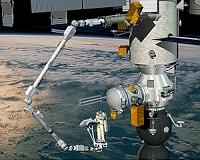 |
Cape Canaveral, Florida (AFP) May 16, 2010 The shuttle Atlantis has linked up with the International Space Station (ISS) for the final rendezvous of its 25-year career, ahead of a first space walk set for Monday. NASA said Atlantis and its crew of six astronauts successfully docked with the orbiting space lab at 1428 GMT Sunday about 220 miles (350 kilometers) above the South Pacific. Its arrival was not without drama as a piece of debris threatened to force Mission Control to order the space station to perform an emergency maneuver to avoid a collision. As things turned out the unidentified piece of space debris passed by safely some five miles away from the docking procedure and no special operation was required. After an hour spent checking the soundness of the seal, the shuttle and station crews opened the hatches and held a traditional welcome ceremony before beginning preparations for the first of three planned spacewalks. NASA said that three station crew members snapped 398 photographs of Atlantis's all-important heat shield on Sunday. "The images were taken as the shuttle performed a back-flip prior to docking... and were sent down to Earth for analysis," the US space agency said in a statement. Mission Specialists Garrett Reisman and Steve Bowen were "'camping out' in the Quest airlock overnight to purge nitrogen from their circulatory system. The pair are preparing for the first of three spacewalks which occurs Monday at 8:15 am (1215 GMT) and is scheduled to last 6.5 hours," NASA added. The mission is the 32nd and final scheduled voyage for Atlantis, which first launched in 1985 and has logged some 115 million miles over a career spanning a quarter of a century. Only two more shuttle launches remain -- one in September for Discovery and the final blast off for Endeavour in November -- before the curtain falls on this era of human spaceflight. The United States will then rely on Russia to take astronauts to the station aboard three-seater Soyuz spacecraft until a new fleet of commercial space taxis is operational. During a mission of almost 13 days, most of which will be spent moored to the ISS, Atlantis and the crew will unload more than 12 tonnes of equipment, including power storage batteries, a communications antenna and a radiator. The biggest single element is the five-ton Rassver research module, or MRM-1, which will provide additional storage space and a new docking port for Russian Soyuz and Progress spacecraft. The Rassver -- "Dawn" in Russian -- will be permanently attached to the bottom of the space station's Zarya module and carries important hardware on its exterior including a radiator, airlock and a European robotic arm. The spacewalks were scheduled to install the new batteries and communications antenna on the space station. President Barack Obama effectively abandoned in February plans laid down by his predecessor George W. Bush to send astronauts back to the moon by 2020 and perhaps on to Mars with a new generation of rocket and spacecraft. Constrained by soaring deficits, Obama submitted a budget to Congress that encouraged NASA to focus instead on developing commercial transport alternatives to ferry astronauts to the ISS after the shuttle program ends. Nonetheless, Obama set a bold new course in April for the future of US space travel, laying out a vision to send American astronauts into Mars orbit within the next three decades. He envisaged the design of a new spacecraft by 2025 for human travel deep into space and said he believed missions to asteroids and to orbit Mars by the mid-2030s were achievable. By the time the final three missions are complete, the space shuttles -- characterized by NASA as the most advanced machines ever built -- will have flown 134 missions into orbit. The ISS, a joint project involving 16 countries, has cost around 100 billion dollars, mostly funded by the United States. NASA said Atlantis would be processed on return as normal just in case she was needed for a "rescue mission" in the event of an emergency with the two remaining shuttle flights. But NASA has not entirely ruled out the possibility of Atlantis taking flight one last time on a comprehensive mission to the ISS next year -- provided Obama gives the go-ahead. "If it happens to turn into a mission to the space station, we will do what is necessary," said NASA launch director Mike Leinbach.
Share This Article With Planet Earth
Related Links Station at NASA Station and More at Roscosmos S.P. Korolev RSC Energia Watch NASA TV via Space.TV Space Station News at Space-Travel.Com
 ESA Giving A Spare Arm To Space Station
ESA Giving A Spare Arm To Space StationParis, France (ESA) May 13, 2010 Space Shuttle Atlantis, ready for liftoff on Friday, will deliver important hardware from Europe to the International Space Station: spare portions of the European Robotic Arm and the first Russian payloads to use the arm. The European Robotic Arm (ERA) is the second 'intelligent' robot arm for the International Space Station (ISS). The first, used extensively for ISS assembly for almost 1 ... read more |
|
| The content herein, unless otherwise known to be public domain, are Copyright 1995-2010 - SpaceDaily. AFP and UPI Wire Stories are copyright Agence France-Presse and United Press International. ESA Portal Reports are copyright European Space Agency. All NASA sourced material is public domain. Additional copyrights may apply in whole or part to other bona fide parties. Advertising does not imply endorsement,agreement or approval of any opinions, statements or information provided by SpaceDaily on any Web page published or hosted by SpaceDaily. Privacy Statement |